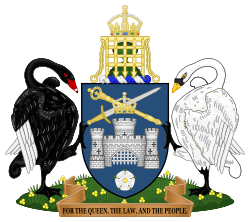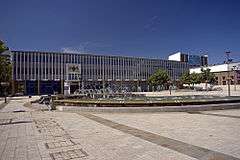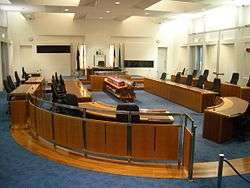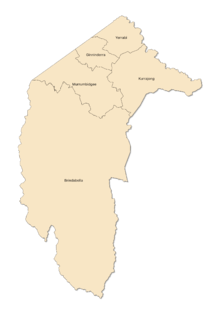Australian Capital Territory Legislative Assembly
| Australian Capital Territory Legislative Assembly | |
|---|---|
 | |
 | |
| Type | |
| Type | |
| Houses | Legislative Assembly |
| History | |
| Founded | 1989 |
| Leadership | |
| Structure | |
| Seats | 25 |
 | |
Legislative Assembly political groups |
Government (14) Labor (12) Greens (2)[Note 1] Opposition Liberal (11) |
| Meeting place | |
 | |
| Legislative Assembly Building, Canberra | |
| Website | |
| www.parliament.act.gov.au | |

The Australian Capital Territory Legislative Assembly (formally the Legislative Assembly for the Australian Capital Territory)[1] is the unicameral legislature of the Australian Capital Territory (ACT). It sits in the Legislative Assembly Building on Civic Square, close to the centre of the city of Canberra.
Creation
The Assembly was created by four acts of the Commonwealth Parliament in 1988, including the Australian Capital Territory (Self-Government) Act 1988. The first election was held on 4 March 1989[2] and the assembly first sat on 11 May that year. Until this point, the ACT had been directly administered by the Commonwealth Government. It replaced the House of Assembly (also known for a period as the Legislative Assembly), which existed from 1976 to 1986, but had no executive power, with a principal function of advising the Commonwealth on matters relating to the Territory.
Membership
Since October 2016, the Legislative Assembly has had five members elected from each of five electorates,[3] Brindabella, Ginninderra, Kurrajong, Murrumbidgee and Yerrabi.[4] Members are elected for four-year terms by the Hare-Clark system, a variation of the Single Transferable Vote form of proportional representation.
Previously the Legislative Assembly had 17 members elected from three electorates—Brindabella and Ginninderra, which each had five members, and Molonglo, which had seven members. In 2014 the Assembly voted to expand the number of members, with the change to take effect at the 2016 election.[5]
The Assembly was originally elected by a modified d'Hondt system, but a 1992 referendum supported the Hare-Clark method, and this was introduced in the 1995 election.
Members of the Legislative Assembly vote to elect a Chief Minister—in practice, the leader of whichever party can form government. The Chief Minister, in turn, selects up to seven ministers to form a cabinet. The leader of the second-largest party in the Assembly usually becomes the Leader of the Opposition.
Election dates for the Assembly are fixed in legislation, with elections held on the third Saturday in October every four years (until 1997, elections were held in February). The term of the Assembly was increased in 2004 from three to four years. The next election is due on 17 October 2020.
Local government functions
Unlike the legislatures of the other mainland states and territories, the Assembly also has the functions of a local council; the city of Canberra has no other local government.
Enactment of legislation
The ACT is unique among Australian states and self-governing territories, as it has no vice-regal post exercising authority as the representative of the monarch, such as a Governor or an Administrator. The functions vested in a state Governor or territorial Administrator as nominal head of the Executive—commissioning government, proroguing parliament and enacting legislation—are exercised by the Assembly itself and by the Chief Minister. Instead of vice-regal or regal assent, a Bill passed by the ACT Legislative Assembly is enacted on "notification"—publication in the Government Gazette of a notice authorised by the Chief Minister.[6] However, the Governor-General of Australia does have the power to dissolve the Assembly if it is "incapable of effectively performing its functions or is conducting its affairs in a grossly improper manner".[7]
Powers
As with the Northern Territory Legislative Assembly, the ACT Legislative Assembly lacks the full powers of a state legislature. Section 122 of the Constitution of Australia provides that the Commonwealth Parliament "may make laws for the government of any territory" surrendered by any State to the Commonwealth. In exercise of that power, the Commonwealth Parliament has enacted the Territories Self-Government Legislation Amendment (Disallowance and Amendment of Laws) Act 2011, which states that the Commonwealth Parliament retains a right to legislate for the Territory in all matters, including power to override laws passed by the Assembly.[8] Although this is rare in practice, the Civil Unions Act 2006, which allowed same-sex couples to enter into "civil unions" was overruled following concerns that the civil unions mimicked marriage. In July 2006, the Federal Government again threatened to overrule the ACT Stanhope Government's anti-terror legislation, which was not consistent with other state laws.
The Commonwealth also retained control of the Territory's justice system until handing it over to the Assembly in 1992.
Current distribution of seats

Australian Capital Territory general election, 2016
| Electorate | Seats held | ||||
|---|---|---|---|---|---|
| Brindabella | |||||
| Ginninderra | |||||
| Kurrajong | |||||
| Murrumbidgee | |||||
| Yerrabi | |||||
In this diagram, the red, blue and green squares indicate assembly members who belong to the ALP, the Liberal Party and the Greens respectively.
- 13 votes as a majority are required to pass legislation.
See also
References
- ↑ Australian Capital Territory (Self-Government) Act 1988, section 8.
- ↑ ACT government elections Archived 28 March 2011 at the Wayback Machine.
- ↑ "A Bill for An Act to amend the Electoral Act 1992" (PDF).
- ↑ "Electorates 2016 election". Retrieved 11 May 2016.
- ↑ "A Bill for An Act to provide for the number of members of the Legislative Assembly" (PDF). Retrieved 11 May 2016.
- ↑ National Archives: Documenting a Democracy
- ↑ Australian Capital Territory (Self-Government) Act 1988, section 16.
- ↑
- ↑ Only 1 of the Greens MP's (Shane Rattenbury) sits in the Cabinet and he retains the right to withdraw from Cabinet discussions and vote against the Government when the two parties disagree.
External links
Coordinates: 35°16′54″S 149°07′52″E / 35.2816°S 149.1312°E
